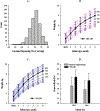Unintentional error in formula preparation and its simulated impact on infant weight and adiposity
- PMID: 31347776
- PMCID: PMC6834868
- DOI: 10.1111/ijpo.12564
Unintentional error in formula preparation and its simulated impact on infant weight and adiposity
Erratum in
-
Correction to "Unintentional error in formula preparation and its simulated impact on infant weight and adiposity".Pediatr Obes. 2023 Nov;18(11):e13074. doi: 10.1111/ijpo.13074. Epub 2023 Aug 25. Pediatr Obes. 2023. PMID: 37622665 No abstract available.
Abstract
Background: Accelerated weight gain in infancy is a public health issue and is likely due to feeding behaviours.
Objectives: To test the accuracy of individuals to dispense infant formula as compared with recommended serving sizes and to estimate the effect of dispensing inaccuracy on infant growth.
Methods: Fifty-three adults dispensed infant formula powder for three servings of 2, 4, 6, and 8 fl oz bottles, in random order. The weight of dispensed infant formula powder was compared with the recommended serving size weight on the nutrition label. A novel mathematical model was used to estimate the impact of formula dispensing on infant weight and adiposity.
Results: Nineteen percent of bottles (20 of 636) prepared contained the recommended amount of infant formula powder. Three percent were underdispensed, and 78% of bottles were overdispensed, resulting in 11% additional infant formula powder. Mathematical modelling feeding 11% above energy requirements exclusively for 6 months for male and female infants suggested infants at the 50th percentile for weight at birth would reach the 75th percentile with increased adiposity by 6 months.
Conclusions: Inaccurate measurement of infant formula powder and overdispensing, which is highly prevalent, specifically, may contribute to rapid weight gain and increased adiposity in formula-fed infants.
Keywords: feeding; infant formula; infant growth; mathematical modelling.
© 2019 World Obesity Federation.
Conflict of interest statement
Figures
Similar articles
-
Modifications to Infant Formula Instructions Improve the Accuracy of Formula Dispensing.Nutrients. 2020 Apr 20;12(4):1150. doi: 10.3390/nu12041150. Nutrients. 2020. PMID: 32325958 Free PMC article. Clinical Trial.
-
Amount, Preparation and Type of Formula Consumed and Its Association with Weight Gain in Infants Participating in the WIC Program in Hawaii and Puerto Rico.Nutrients. 2019 Mar 24;11(3):695. doi: 10.3390/nu11030695. Nutrients. 2019. PMID: 30909642 Free PMC article.
-
Associations of infant feeding with trajectories of body composition and growth.Am J Clin Nutr. 2017 Aug;106(2):491-498. doi: 10.3945/ajcn.116.151126. Epub 2017 Jun 28. Am J Clin Nutr. 2017. PMID: 28659299 Free PMC article.
-
Dilute versus full-strength formula in exclusively formula-fed preterm or low birth weight infants.Cochrane Database Syst Rev. 2019 Jun 27;6(6):CD007263. doi: 10.1002/14651858.CD007263.pub3. Cochrane Database Syst Rev. 2019. PMID: 31246272 Free PMC article.
-
Growth of breast-fed and formula-fed infants.Nestle Nutr Workshop Ser Pediatr Program. 2006;58:51-9; discussion 59-63. doi: 10.1159/000095010. Nestle Nutr Workshop Ser Pediatr Program. 2006. PMID: 16902325 Review.
Cited by
-
Low-Protein Infant Formula and Obesity Risk.Nutrients. 2022 Jun 30;14(13):2728. doi: 10.3390/nu14132728. Nutrients. 2022. PMID: 35807908 Free PMC article. Review.
-
Perspective: Supporting Maternal Efforts to Provide Optimal Infant Nutrition in the Post-Partum Setting.Adv Nutr. 2024 Mar;15(3):100183. doi: 10.1016/j.advnut.2024.100183. Epub 2024 Feb 2. Adv Nutr. 2024. PMID: 38309530 Free PMC article.
-
New frontiers in the measurement of energy metabolism.Am J Physiol Endocrinol Metab. 2023 Sep 1;325(3):E239-E243. doi: 10.1152/ajpendo.00070.2023. Epub 2023 Jul 26. Am J Physiol Endocrinol Metab. 2023. PMID: 37493244 Free PMC article.
-
Some Japanese mothers do not follow package instructions of infant formula: a web-based analytical cross-sectional study.BMC Nutr. 2022 Nov 1;8(1):126. doi: 10.1186/s40795-022-00615-7. BMC Nutr. 2022. PMID: 36319983 Free PMC article.
-
Tailored recommendations for infant milk formula intake results in more accurate feeding.Eur J Pediatr. 2024 Nov;183(11):4693-4704. doi: 10.1007/s00431-024-05726-w. Epub 2024 Aug 26. Eur J Pediatr. 2024. PMID: 39186085 Free PMC article.
References
-
- Plagemann A, Harder T, Schellong K, Schulz S, Stupin JH. Early postnatal life as a critical time window for determination of long-term metabolic health. Best Pract Res Clin Endocrinol Metab 2012;26(5):641–653. - PubMed
-
- CDC. National Immunization Surveys 2012 and 2013 2014. http://www.cdc.gov/breastfeeding/data/reportcard.htm.
-
- Li R, Magadia J, Fein SB, Grummer-Strawn LM. Risk of bottle-feeding for rapid weight gain during the first year of life. Archives of pediatrics & adolescent medicine 2012;166(5):431–436. - PubMed
Publication types
MeSH terms
Grants and funding
LinkOut - more resources
Full Text Sources
Medical


